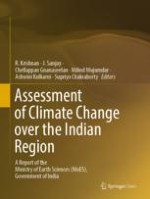-
There has been a decreasing trend in the all-India annual, as well as summer monsoon mean rainfall during 1951–2015, notably so over areas in the Indo-Gangetic Plains and the Western Ghats. Increasing concentrations of anthropogenic aerosols over the northern hemisphere appear to have played a role in these changes (medium confidence).
-
The frequency of localized heavy rain occurrences over India has increased during 1951–2015 (high confidence). Urbanization and other land use, as well as aerosols, likely contribute to these localized heavy rainfall occurrence (medium confidence).
-
With continued global warming and expected reductions of aerosol concentrations in the future, climate models project an increase in the annual and summer monsoon mean rainfall, as well as frequency of heavy rain occurrences over most parts of India during the twenty-first century (medium confidence).
-
The interannual variability of summer monsoon rainfall is projected to increase through the twenty-first century (high confidence).
3.1 Introduction
3.2 Observed Changes in Mean Precipitation and Circulation
3.2.1 Precipitation Records in Paleo Time Scale—Inferences from Proxies
3.2.2 Recent Changes in Precipitation
3.2.3 Understanding the Observed Changes in the Summer Monsoon Precipitation
3.2.3.1 Anthropogenic Causes of Observed Precipitation Changes
3.2.3.2 Changes in Circulation Features
3.2.3.3 Observed Changes in Active/Break Spells
3.2.3.4 Changes in Onset Characteristics
3.3 Projected Changes in Precipitation Over India
Monsoon | Post-monsoon | Annual | |
|---|---|---|---|
Seasons | JJAS | OND | |
Mean (mm) | 858.0 | 119.1 | 1142.1 |
Std Dev | 80.2 | 29.5 | 98.8 |
% Contribution to annual average | 75.1 | 10.4 | |
Max RF (Year) | 1011.7 (1988) | 205.1 (1956) | 1359.6 (1990) |
Min RF (Year) | 665.2 (1972) | 63.5 (2011) | 922.4 (1972) |
CORDEX -SA | RCM used | Contributing RCM modelling centre | Driving CMIP5 model | CMIP5 modelling centre |
|---|---|---|---|---|
IITM-RegCM4 | ICTP, regional climate model version 4 (Giorgie et al. 2012) | CCCR, IITM, India | CCCma-CanESM2 | Canadian Centre for Climate Modelling and Analysis (CCCma), Canada |
NOAA-GFDL-ESM2M | National Oceanic and Atmospheric Administration-Geophysical Fluid Dynamics Laboratory, USA | |||
CNRM-CM5 | Centre National de Recherches Météorologiques, France | |||
MPI-ESM-MR | Max Planck Institute for Meteorology, Germany | |||
IPSL-CM5A-LR | The Institute Pierre Simon Laplace, France | |||
CSIRO-Mk.6 | Commonwealth Scientific and Industrial Research Organisation, Australia | |||
SMHI-RCA4 | Rossby Centre regional atmospheric model version 4 (Samuelsson et al. 2011) | Rossby Centre, Swedish Meteorological and Hydrological Institute, Sweden | ICHEC-EC-EARTH | Irish Centre for High End Computing, European Consortium |
MIROC-MIROC5 | Model for Interdisciplinary Research On Climate, Japan Agency for Marine-Earth Science and Technology, Japan | |||
NCC NorESM1 | Norwegian Climate Centre, Norway | |||
MOHC-HadGEMEM2-ES | Met Office Hadley Centre for Climate Change, UK | |||
CCCma-CanESM2 | Canadian Centre for Climate Modelling and Analysis (CCCma), Canada | |||
NOAA-GFDL-ESM2m | National Oceanic and Atmospheric Administration-Geophysical Fluid Dynamics Laboratory, USA | |||
CNRM-CM5 | Centre National de Recherches Météorologiques, France | |||
MPI-CM5A-MR | Max Planck Institute for Meteorology, Germany | |||
IPSL-CM5A-MR | The Institute Pierre Simon Laplace, France | |||
CSIRO-Mk.6 | Commonwealth Scientific and Industrial Research Organisation, Australia |
CMIP5 | NEX | CMIP5 modelling centre |
|---|---|---|
ACCESS1-0 | Ϯ | Australian Community Climate and Earth System Simulator, Australia |
BNU-ESM | Ϯ | Beijing Normal University Earth System Model, China |
BCC-CSM1-1 | Ϯ | Beijing Climate Centre Climate System Model, China |
CCSM4 CESM1-BGC | Ϯ Ϯ | Community Climate System Model, NCAR, USA |
CNRM-CM5 | Ϯ | Meteo-France/Centre National de Recherches Meteorologiques, France |
CanESM2 | Ϯ | Canadian Centre for Climate Modelling and Analysis (CCCma), Canada |
CMCC-CM | Centro Euro-Mediterraneo sui Cambiamenti Climatici, Italy | |
CSIRO-Mk3-6-0 | Ϯ | Commonwealth Scientific and Industrial Research Organisation (CSIRO), Australia |
GFDL-ESM2M GFDL-ESM2G GFDL-CM3 | Ϯ Ϯ Ϯ | Geophysical Fluid Dynamics Laboratory, National Oceanic and Atmospheric Administration (NOAA), USA |
GISS-E2H GISS-E2-R | National Aeronautics and Space Administration (NASA)/Goddard Institute for Space Studies (GISS), USA | |
HadCM3 HadGEM2-ES HadGEM2 CC | Met Office Hadley Centre, UK | |
INMCM4 | Ϯ | Institute for Numerical Mathematics, Russia |
IPSL-CM5A-MR IPSL-CM5A-LR | Ϯ Ϯ | Institute Pierre Simon Laplace, France |
MIROC5 MIROC-ESM-CHEM MIROC-ESM | Ϯ | Centre for Climate System Research (University of Tokyo), National Institute for Environmental Studies and Frontier Research Center for Global Change (JAMSTEC), Japan |
MPI-ESM-LR MPI-ESM-MR MRI-CGCM3 | Ϯ Ϯ Ϯ | Max Planck Institute for Meteorology, Germany |
MRI-CGCM3 | Meteorological Research Institute, Japan | |
NorESM1-M | Ϯ | Norwegian Climate Centre, Norway |
Scenario | Experiments | Annual | |
|---|---|---|---|
Near future | RCP 4.5 | CMIP5 | 0.12 ± 0.11 (91%) |
CORDEX | 0.16 ± 0.19 (118%) | ||
NEX | 0.20 ± 0.21 (105%) | ||
RCP 8.5 | CMIP5 | 0.20 ± 0.17 (85%) | |
CORDEX | 0.28 ± 0.18 (64%) | ||
NEX | 0.38 ± 0.20 (52%) | ||
Far future | RCP 4.5 | CMIP5 | 0.25 ± 0.18 (72%) |
CORDEX | 0.32 ± 0.22 (68%) | ||
NEX | 0.40 ± 0.23 (57%) | ||
RCP 8.5 | CMIP5 | 0.45 ± 0.21 (46%) | |
CORDEX | 0.58 ± 0.32 (55%) | ||
NEX | 0.63 ± 0.31 (49%) |
